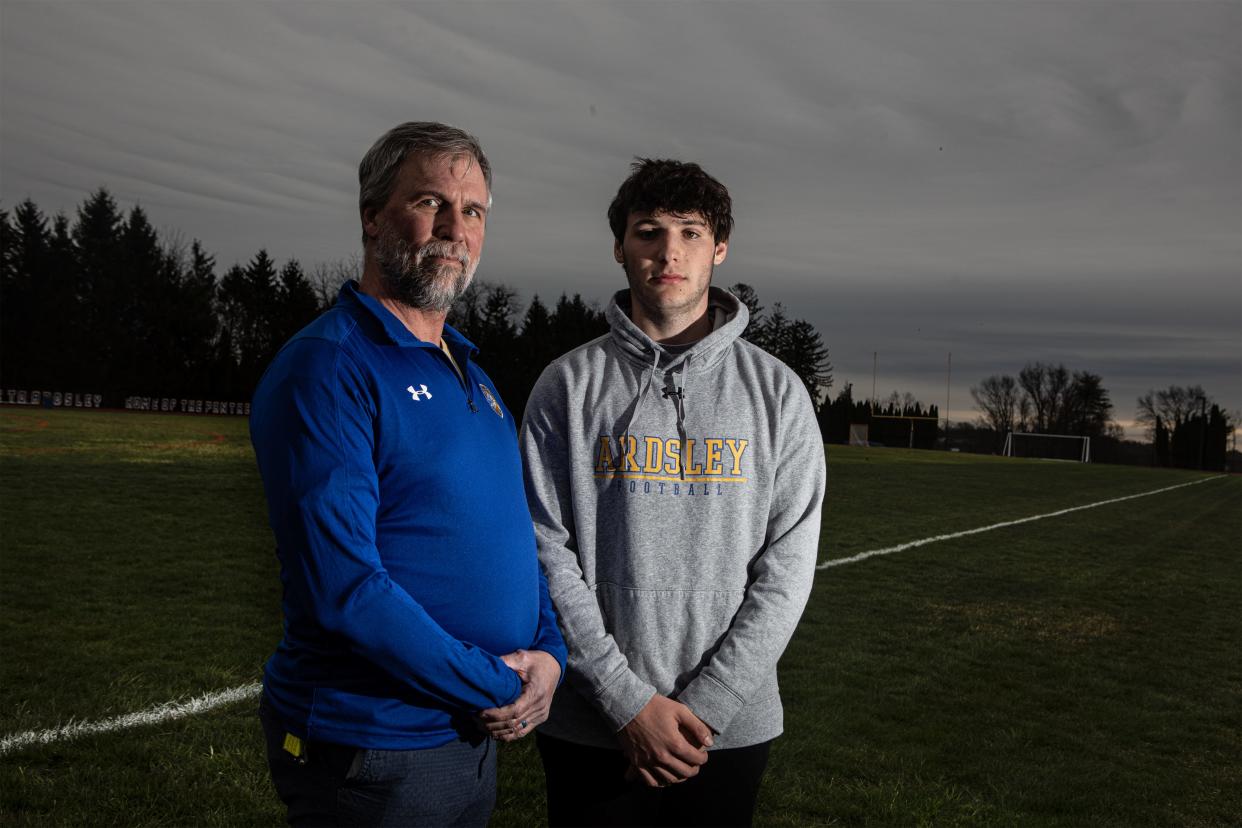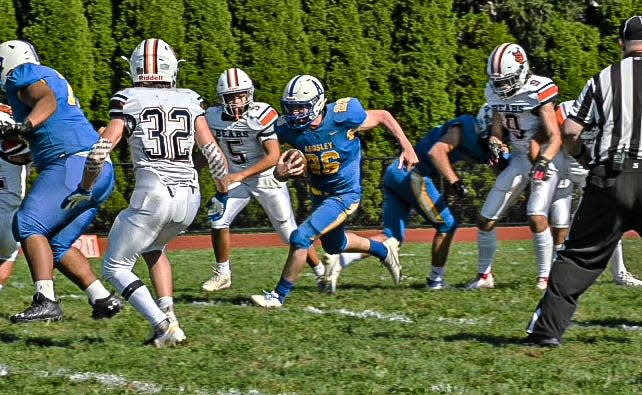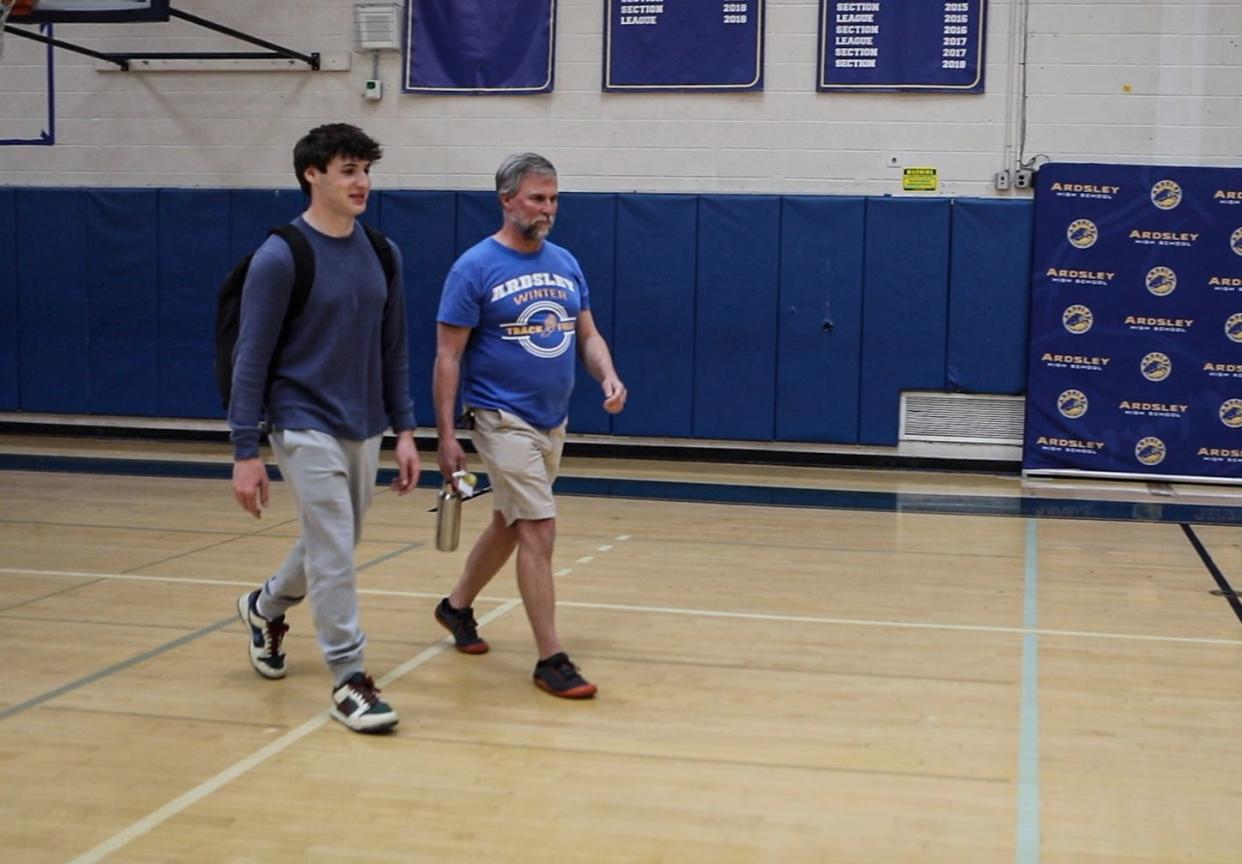'Concussions are no joke.' Westchester player let football go after multiple concussions
ARDSLEY − There were three concussions. The third far worse than the others.
But Ardsley High School senior Tyler Siden was still on the fence. Emotions pulled him in one direction, reasoned fear pulled him in another.
He planned to go to college and study engineering. So, math, obviously, was never a problem.
And, yet, in an early attempt to return to school after that third concussion in the fall of 2022, making it through a single math class proved impossible.

"I couldn't do the work. I fogged out... I couldn't do anything," Siden said.
That last concussion had kept him out of school for three weeks, not counting the math class two weeks in.
But now he could read fine and write fine, and look at phones and computers just fine. All things he couldn't do at all for many days after concussion No. 3, which saw him repeatedly flunk every balance test the school's trainer had him take.
Stand on one foot? He couldn't.
Walk backward in a straight line? Walk forward in a straight line? No and no.
Walk blindfolded? Yeah, right.
By the time football workouts started up last summer, he was finally cleared to return to sports if he wanted to.
When you've had a football in your hand almost since the time you could walk, and you started looking at the high school varsity players as almost football gods when you were 7 years old, your dream to be on that team is long-held. He didn't want to miss his senior season, his "spotlight moment."
"I was itching to get back out there," Siden said. "All I ever wanted to do was play football."

And, so, Siden, whose last game had ended one play after his head whiplashed to the extent a doctor told him he'd lost seconds of blood flow and oxygen to his brain, suited up for Ardsley's annual preseason Blue and Gold team scrimmage.
On the very first play, Siden ran a good, short rout and pulled in the ball for a 15-yard gain. He felt good.
But then, in a blink, he got a headache. It was a reminder of everything he'd been through.
Siden's parents told him he could make the decision about whether or not to play in the fall.
After two "really hard days of self-reflection" in which he took a "hard look at the future," Siden decided his place was on the sidelines, out of uniform. Cheering, not playing.
It was a decision his doctor, the school's athletic trainer and his parents all applauded as smart. But it still "really hurt."
Concussions still a game-changer
It's unclear how many athletes give up a sport each year because of fear of what repeated concussions may mean five years, or 50 years, in the future.
But the answer is probably a lot, certainly since Concussion Crisis headlines started rocking everything from the NFL to grade-school football and other contact sports more than a decade ago.

Despite the implementation of various safety rules that athletic trainers greatly endorse − among them, in football, limited tackling in practice and no tackling by leading with the head − concussions remain a part of many sports, of course including football.
At Ardsley High School alone, athletic trainer Douglas Sawyer believes safety rules have slashed the number of concussions that occur, but still says about 15 Ardsley students have suffered concussions so far this school year.
Most of those occurred during sports, although three of them (one ice hockey, two soccer) happened while athletes were playing for their outside travel teams, where concussion-playing rules are generally regarded as lax or non-existent.
Sawyer is a veteran athletic trainer with 28 years on the job, including 19 at Hackley School before he moved to Ardsley about two-and-a-half years ago. Siden isn't the only athlete Sawyer has worked with who ultimately discontinued participating in a sport because of concussions.
Sawyer also recalls a seventh-grader who went head-first into a soccer goalpost. The concussion was so severe the athlete had to receive outside vestibular rehabilitation, which is designed to address things like persistent balance impairment and dizziness. Future participation in any contact sport was ruled out.
Another was a high school football player in 2001, well before concussions grabbed national attention with revelations of athletes − including former NFL players − playing with them and suffering brain damage.
The concussed football player was cleared by a doctor to play. But Sawyer evaluated him and found "something was not right."
He talked to the boy and his family. Ultimately, the boy didn't play. His senior season, like Siden's, was lost. The head coach was angry.
But the next year, that kid stopped by school and thanked Sawyer. He told him he still had problems with short-term memory and still had headaches. He was grateful he hadn't played, which could have made things much worse.
Joe Grispin, who has been Sleepy Hollow High School's athletic trainer since the fall and worked for a few years before that at Wilton (Connecticut) High after graduating from Stony Brook University, lived with a Stony Brook ice hockey teammate who suffered six concussions in one year. A very good student, the player decided to quit playing because the concussions were affecting his academic performance, Grispin recalled.
While athletic trainers say testing and education have made it much less common for concussions to go undetected, some concussions, Grispin noted, aren't immediately apparent because symptoms can take time to develop.
He recalled several instances in which players passed sideline concussion tests then, minutes later, didn't recall taking the test.
North Rockland's Carol Guzinski, who has worked as an athletic trainer for 35 years and began when concussions were viewed just as brain bruises, said today's kids, who have grown up knowing about concussions, are more accepting of the diagnosis than some parents, who recall playing while dizzy or with headaches.
"If you have symptoms, you have a concussion," she said flatly.
If there's one message Grispin would like everyone from concussed athletes to teammates, to coaches, to parents to understand, it's that, "There is no minor concussion."
Guzinski, fearing the potential long-term and even life-long impact of multiple concussions, will battle to keep kids off playing fields until they're completely healthy.
"Our job is to worry. I'd rather you be around in 10 years and hate me," she said. "It's your brain. Your whole life. Nothing is worth that. ... If you get multiple-concussion effects, no high school sport is worth that."
Siden's decision and history
Siden, who still plays golf for Ardsley, protected his long-term health by opting out of playing football.
He knew too well what it felt like to live with the symptoms in the short term and didn't want that, or worse, down the road.
His first middle-school concussion occurred when he slipped on the bottom of a poll, slamming his head against the side. He became dizzy and was taken to urgent care. But he was back to his old self in days.
His second concussion came while playing middle-school football. He was hit from behind and essentially landed on his head.
He spent five days in a dark room − an often prescribed treatment, at the time − and missed three days of school.
His third concussion came late in the 2022 regular season. Siden was on the field for a kickoff when an opponent's helmet came under his facemask, whipping Siden's head back and forth.
"I instantly knew something was wrong," he said.
Along the sidelines, he was walking around, looking at the field's lights and his feet and hands. A coach asked him if he was OK.
Siden thought he'd just gotten his "bell rung," a description athletic trainers now abhor as an old-school term minimizing a very real problem.
He went back into the game, lasting one play before removing himself.
"That's why all the concussion awareness is super important. You have your adrenaline running," Siden said of returning, speculating someone might go back in for another 20 plays, unaware he or she might have a concussion.
The next day, driving to a friend's house on Long Island, he felt car sick, something that hadn't happened before. And things got progressively worse.
"It wasn't until later that I got extremely drowsy and disoriented. I called my parents and said, 'I think I have a concussion.' We put two and two together."
He returned home and slept for 16 hours. Then he slept for 16 hours the next day, and again the next.
He went to neuropsychologist Dr. Mark Herceg, who specializes in concussions. Low-level aerobic exercise was gradually increased. It took about two months for Siden to pass tests that allowed him to return to sports.
But playing wasn't initially at the center of his concern. Just being able to be back to feeling OK was.
"Lights really bothered me. Noise. Sitting upright. Stimuluses. Everything around me was irritating me and making me sick," Siden said of his early post-concussion world.
Concussion treatment had advanced in the years between his second concussion in 2018 and his third last fall. Gone was the treatment of sitting in a dark room. Gone was the ban on using electronics. But Siden couldn't use anything up close. He could watch some TV with the TV across a room. But he could't write or read. So, even though it was cold, he'd often sit outside two or three times a day to break the monotony.
"I'd eat dinner and go to bed. It was really a sad and dark cycle. I'd feel like a zombie and horrible. I did not have a lot of contact with people. It takes a toll on you mentally," he said.
Making the best of things
Working with Herceg and Sawyer, Siden got better, returning to school after three weeks and passing clearance testing to play sports last spring − in Siden's case, golf.
In the fall, he made himself as much a part of the football team as any non-player could.
"I went to every single game. I stood on the sideline. I went to the team dinner every night before games," he said, noting he even attended a bunch of practices.
But sometimes, he'd have to tune out those who didn't understand why the former fullback and linebacker, who looked OK, wasn't playing.
"There definitely were some players giving me a hard time about it. And I can understand why. It's easy from the outside to say, 'Just toughen up. You'll be okay'," he said. "Definitely a lot of people told me, 'Tough it out. You're a good player,' or the team needed me.
"I think for people who don't understand what I went through, it's easy to say, 'toughen up.' Concussion is a non-visible injury. People think it's not true."
But Siden, as torn as he was, knew sitting out was the right thing to do.
"Concussions are no joke. Over time, they have serious impacts on people's physical and mental health," he said. "It's important for people to take the necessary action to get healthy."
And more people, including his coaches, were supportive than those who were not.
Siden said if he'd been on track to play college football, or football was his only way to go to college, his already-tough decision about playing his senior year would have been much tougher.
But, as it is, he still worries about the future, allowing himself to mentally travel to the "darker side" of what happened and worry about the blows he took to his head and their possible long-term impact on his cognitive ability and whether there's any chance he could develop CTE, a degenerative brain disorder associated with multiple head injuries.
"It's still lingering to this day, all the 'what ifs,' and the memories I would have made on the field," he said. "But I think there's also relief now I didn't play because I wouldn't know what would happen."
Nancy Haggerty covers cross-country, track & field, field hockey, skiing, ice hockey, basketball, girls lacrosse and other sporting events for The Journal News/lohud. Follow her on Twitter at @HaggertyNancy.
This article originally appeared on Rockland/Westchester Journal News: Ardsley NY football: Tyler Siden lets go after multiple concussions
